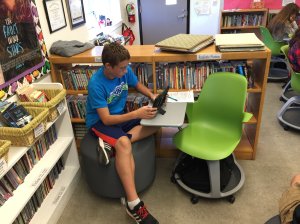#ThinkPossible: Challenging Students to be Novelists

“No! Oh, my god, NO! Don’t do it! They will run screaming from the classroom! They will sob and cry and refuse! I beg of you, do not do this!”
What could possibly cause such a vehemently negative reaction from a creative, seasoned teacher? I was chatting with this respected colleague about a project that I thought my 8th grade students would enjoy. As you can see, he didn’t exactly agree.
“You know there will be some kids who will love this - you can always find a creative writer or two in every class - but to assign this to all your students? Crazy. Impossible. Don’t do it.”
My daughter had introduced me to National Novel Writing Month (NaNoWriMo for short), a bold (and, admittedly, somewhat crazy) endeavor in which one attempts to write a draft of a novel in the month of November. I agreed with my colleague that it sounded like an impossible challenge to toss out to 13 year-olds, but I had discovered a fantastic organization that had transformed the adult version into a challenging yet accessible project that teachers could bring to their students.
The Young Writers Program of NaNoWriMo provides curriculum that supports both teachers and students in preparing for the November challenge, as well as tips for persevering throughout the month-long wild writing ride. Novel-writing workbooks are available as PDF downloads, a gold mine for teachers who may wonder how, if they’ve never written a novel themselves, they could possibly support their students in the task. The NaNoWriMo website brings author pep talks, writing advice, and a social network for the students that inducts them into an enthusiastic writing community.
This is all offered free of cost, and the good folks at the Young Writers Program are available online to support teachers throughout this bold challenge. Worried that an administrator won’t support your plan to cancel all English classwork and homework for a month so your students can write a novel? Not to worry: the Young Writers Program has tallied up the many ways that NaNoWriMo meets the Common Core Standards.
I’m so glad I ignored my friend’s advice (I know he meant well; I mean - really! - who thinks it’s a good idea to frighten 8th graders with the longest writing assignment they’ve ever seen?). But when I introduced the project to my 8th graders in 2011, in spite of some fear and trepidation, nearly every student eventually became immersed in the joys of creating their own story; of owning the plot, characters, settings, and conflicts; of making the many writerly decisions that must be made when crafting a story of such length. They celebrated one another’s achievements as they watched their word counts grow towards their goals; they shared strategies for breaking through writers’ block; they jumped into one another’s Google Docs to comment on (and give wild suggestions to) each other during writing time.
And when the month was over, that first brave group of students celebrated when 96% of them reached their goal by November 30. The remaining 4%? They just kept writing, because even if NaNoWriMo ended, these kids still had stories to finish writing.
Every year now since 2012, every single 8th grader at our school jumps on board the novel-writing train, and the campus buzzes with nearly 500 novelists chatting at lunch about their stories: “How many words did you write today?” “Listen to my dystopian world idea!” “I had to kill off a character yesterday!” And even though we eventually have to set aside our novels and move on to expository writing, many of our students make time to revise, edit, and complete a final draft of their novel, which they then publish and sell on Amazon.
There is a sweet spot that we need to find for our students, that magic place between too easy and too hard. Our students want to be challenged, they want to be engaged in their learning, and endeavors like NaNoWriMo give them that opportunity. How can we argue with a response like this from Jessie, a not-so-enthusiastic student who fell in love with writing that year: “It made me think that a lot of things could be possible in the world. I mean I am thirteen years old and I just wrote my own dang novel! How cool is that?”
Let’s find those challenges for our kids, those seemingly impossible tasks that make them feel like “lots of things could be possible in the world.” They deserve to #ThinkPossible.
Update 2025: The original NaNoWriMo organization folded in early 2025, but the classroom resources for young writers are available on NaNo2.org.